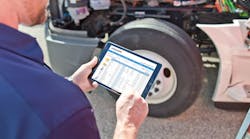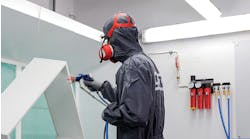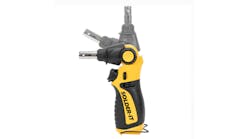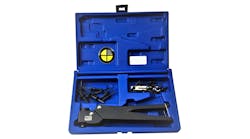A popular buzzword that’s been echoed across the commercial fleet industry in recent years is “uptime.” Fleet managers are on a perpetual quest to ensure their vehicles are operating at full capacity in an effort to maximize vehicle uptime—and profitability.
While innovations in fleet management technology, advanced driver assistance systems, and telematics have helped fleets keep their trucks on the road longer, what happens when the inevitable occurs and a truck is sidelined for collision repair or repaint work? With the assumption that an inactive truck results in lost revenue, what’s the best way to expedite the repair and put the vehicle back on the road as quickly as possible?
The solution for a growing number of fleet managers and commercial vehicle repair centers is an automated commercial vehicle estimating system. By substantially reducing the time it takes to write a highly accurate estimate, this type of system can also help improve a shop’s overall cycle time—because repair work doesn’t begin until an estimate is completed.
To help fleet managers and repair operations better understand the advantages of automated estimating, here are some frequently asked questions and answers I have found in nearly two decades working with the technology.
How does an automated repair estimator work?
A well-developed electronic estimating system will feature access to a comprehensive database that contains all the information needed to quickly produce a complete estimate. This will take into consideration actual truck model information compiled from truck parts, parts pricing, refinish labor and more. By factoring in all of this information electronically, a detailed, professional-looking repair estimate can be produced with “point and click” simplicity and speed.
How does automated estimating compare to the conventional method of creating an estimate?
Hand-written estimates are fairly simple and typically involve a clipboard and several sheets of paper. The task of the estimator is to write a scope-of-damage report at the site of the damaged vehicle to list the items that need to be repaired or replaced, and then return to the office to manually search through vehicle estimating workbooks and jot down information on parts, pricing, estimated labor time, refinish labor, etc.
When manually building a 200-300 row estimate, the conventional method can take hours to complete. With electronic estimating, parts can be selected very quickly and added to the estimate. The key difference is that a part can be chosen from a populated list of options, as opposed to searching for the part in a workbook. Using an automated system gives you the potential to create an estimate in a one-third the time it would otherwise require.
Document security is another drawback of the conventional estimating approach. If a manually created estimate is misplaced, the estimator will need to recalculate because there is no electronic record. An electronically created estimate, on the other hand, can be easily retrieved since it’s stored on a server for easy access from anywhere.
What should truck estimators look for in an automated commercial repair estimator?
The number one priority is quality data. For example, it’s ideal if an estimating system provides a comprehensive parts listing, with each part having associated body, paint, mechanical and frame labor times. This feature can be a major time saver since labor and associated costs are automatically calculated when the part is selected.
I can’t speak for all estimating systems, but in a nutshell, data for the PPG AdjustRite system is accumulated through visits to multiple service center locations, where studies are performed to evaluate the average time it takes to complete specific repairs. From there, we build out robust parts lists and associate them with the labor times we’ve studied—along with proprietary information from our experience as a commercial coatings leader—to create the databases we feature in our automated estimating system. It stand to reason that he longer a system has been in operation, the stronger the database—and the more historical information that can be incorporated.
Using a cloud-based estimating system also provides benefits. This allows an estimate to be written from the site of a damaged truck or from any location, as long as there’s access to the internet. However, not all estimating programs provide cloud-based connectivity, so you’ll want to do your homework.
How accurate are automated estimating systems?
Again, I can’t provide an answer for the other systems out there, but I can speak to the PPG AdjustRite platform.
Our system is comprehensive to the point we try to factor in virtually every variable for a given repair. In fact, the PPG AdjustRite system can produce estimates that are so accurate, it offers the opportunity for a shop to present one to a customer as a binding quote.
This is made possible in part because our system’s proprietary “logic” considers each repair part in its relationship to other items and work functions. For example, if a replacement fender is selected, the system will prompt for add-on labor, parts, paint and materials, and automatically add for hazardous waste disposal, clear coat and shop supplies. The result is a well-documented, extremely accurate estimate.
If an estimating systems does not have a logic-based function, it’s possible to overlook a certain percentage of costs attributed to parts and/or labor. Even if this number is just 5%, a job estimated at $20,000 could be missing up to $1,000 in costs for these items.
What does the future hold for estimating platforms?
They’ll definitely become more popular, and as the industry evolves, they’ll keep getting better. The key for success in this arena is the ability to adapt to the needs of the customer. For example, we recently announced that the PPG AdjustRite system is available to the RV market. This provides fleet repair facilities that also service RV vehicles with the unique ability to quickly generate detailed and accurate collision repair estimates. We developed this capability based on customer feedback, which will always be a motivating factor as we continue to advance our estimating system over the coming years.
The bottom line is that automated estimating works really well. And I truly believe that any shop that brings one in will never go back to a conventional platform.
With over 18 years of experience working in the commercial estimating segment, Doug Orr brings a wealth of hands-on knowledge to his current role as manager of the PPG AdjustRite commercial estimating system. In this leadership position, Doug oversees a number of vital functions including development and support team management, database development and maintenance, system training, and the capture and mapping of reference images. For more information about the PPG AdjustRite commercial estimating system, call 941-391-1001 or visit www.adjustrite.com.



